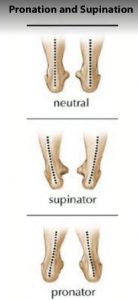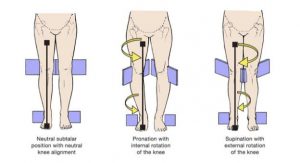
As the weather breaks and temperatures begin to rise, our pathways and streets will be filled with avid and new runners. We’ve been cooped up inside all winter and running on the dreaded treadmill like a hamster on its wheel-going nowhere soon. There are a few things we want to remember as we prepare to hit the pavement. We want to prevent injuries and keep our risk of developing new injuries or triggering old ones.
 Healthy feet are integral to a healthy body. Their purpose is to evenly distribute our body weight, while balancing the gravitational pull with the atmospheric pressure exerted on the body. Our feet provide stability by becoming a counter balance during ambulation. Factors such as weight, pelvic position, hip position, Q-angle ( genu-varum { bow-legged} or genu-valgus {knock-kneed}), foot type ( pes planus{flat} or pes cavus{high arches}) all play a significant role in physical manifestations and compensatory mechanisms.
Healthy feet are integral to a healthy body. Their purpose is to evenly distribute our body weight, while balancing the gravitational pull with the atmospheric pressure exerted on the body. Our feet provide stability by becoming a counter balance during ambulation. Factors such as weight, pelvic position, hip position, Q-angle ( genu-varum { bow-legged} or genu-valgus {knock-kneed}), foot type ( pes planus{flat} or pes cavus{high arches}) all play a significant role in physical manifestations and compensatory mechanisms.
If our feet cannot support our weight, we begin to see muscle imbalances, inability to maintain postural balance (increased fall risks) and the development of compensatory mechanism with the body structure.
Two common misalignments of the feet are over-pronation or over-supination. The lumbo-pelvic hip complex is an important aspect to overall body balance. If there is any disruption in this alignment it can cause other misalignments throughout the body. This can make a runner prone to certain injuries as a result of foot orientation, position and foot strike. A review examining the relationship between foot motion and lumbopelvic-hip function states this “Foot pronation has been proposed to propagate more proximal lower limb dysfunction and hence contribute to a wide range of lower limb injuries affecting the lower back, hip, knee, lower leg, ankle and foot.” (Barwick, etal, 2012)
In a study researching the relationships between foot posture and plantar pressure, one possible correlation was made “High arches have been associated with more laterally located bony injuries of the foot, foot pain, ankle injuries, knee pain, and lower extremity stress fractures. Low arches have been associated with soft tissue injuries such as patellar tendinitis, plantar fasciitis, and knee pain.” (Jonely, etal, 2011) What we understand from this body of research is that foot shape does matter and greatly affects the biomechanics of the entire movement system. Some injuries common to runners are: ankle sprains/strains, plantar fasciitis, shin splints, Achilles’ tendonitis, IT band syndrome, and patellofemoral syndrome (abnormal patella tracking). Most of these conditions are a result of either improper body positioning, over-use or a result of compensatory mechanism. We can prevent and/or decrease the risk of developing or agitating these conditions through: proper shoe selection and replacement, proper muscle recruitment patterns and remaining flexible through stretching and myofascial release.
Happy Running!

Barwick, A., etal. (2012). The relationship between foot motion and lumbopelvic-hip function: A review of the literature. The Foot. Volume 22 (2012) pp224-231
Jonely, H. etal. (2011). Relationships between clinical measures of static foot posture and plantar pressure during static standing and walking. Clinical Biomechanics. Volume 26 (2011) pp873-879
